Dinosaurs are some of the most fascinating animals to have ever walked the earth, roaming the landscape for millions of years. There were thousands of different species, both large and small, and with various unique features. So, let’s take a look at the complete list of dinosaurs that start with C!
1. Camarasaurus
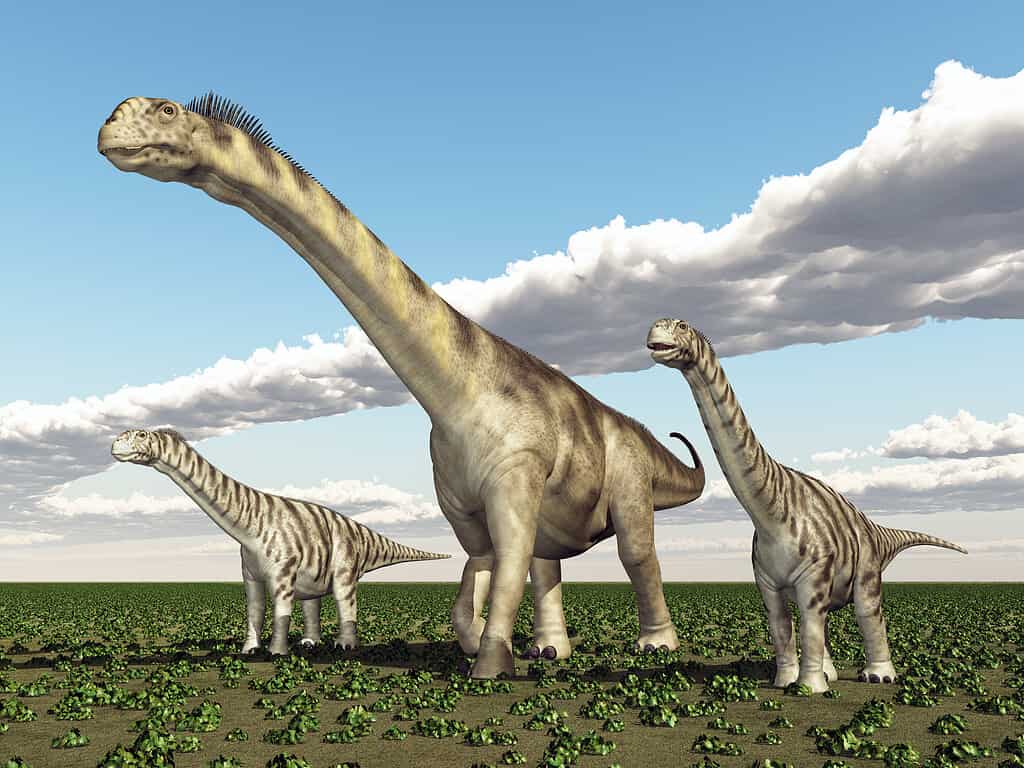
was a huge herbivorous dinosaur that reached 75 feet long.
©MR1805/iStock via Getty Images
The first dinosaur on the list is the Camarasaurus, whose name means “chambered lizard”. The Camarasaurus was a huge sauropod that had a length of up to 75 feet. Camarasaurus lived during the Late Jurassic period and was fairly widespread across the area that is now North America, with fossils found in several states. It had a long neck and a fairly blunt snout. It also had sharp, chisel-shaped teeth, although as a herbivore it only used them for chewing leaves and plants.
2. Camptosaurus
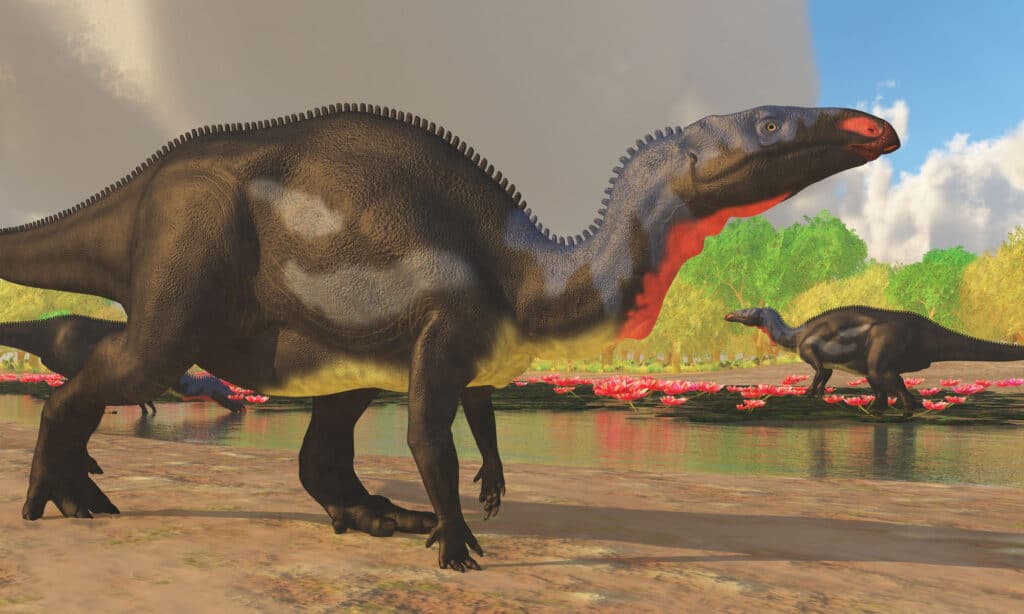
had a beak-like structure on its snout for pulling up vegetation.
©iStock.com/CoreyFord
Another dinosaur from the Late Jurassic period is Camptosaurus, which was an ornithopod. Its name literally means “bent lizard”, in part because of its ability to walk on either two or four legs. Camptosaurus had a stocky, heavy body and was estimated to have been up to 22 feet long. Like Camarasaurus, Camptosaurus was a herbivore and ate a variety of plants. Camptosaurus also had a beak-like structure on its head which it used to to pull vegetation up with.
3. Carcharodontosaurus
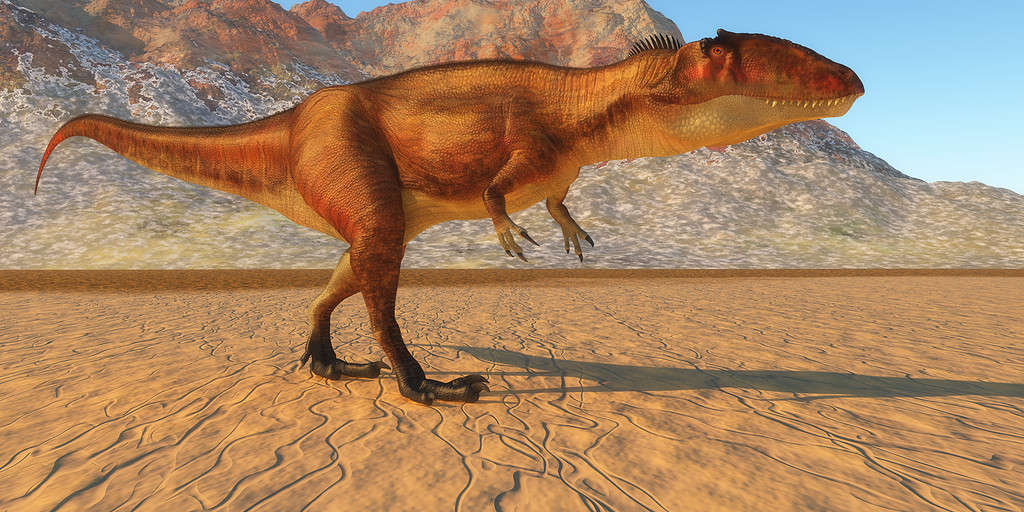
was a carnivorous theropod dinosaur that lived in North
Africa
in the Late Cretaceous period.
©Catmando/Shutterstock.com
Another dinosaur beginning with C is Carcharodontosaurus, which was a large theropod that reached around 41 feet long. Carcharodontosaurus lived during the Late Cretaceous era across North Africa. It was a carnivore and would have preyed on a variety of other dinosaurs.
One of the most fascinating things about Carcharodontosaurus is its teeth, which closely resemble shark teeth, leading to its name which means “shark-toothed lizard”. This is because they are particularly similar to the teeth of great white sharks, who are members of the Cararcharodon genus. Carcharodontosaurus teeth could be as much as eight inches long and were slightly curved with small serrations along the edge. However, they weren’t as robust as other theropods of a similar size — such as the Tyrannosaurus rex — meaning that the teeth were more prone to breaking, especially if they came into contact with bone.
4. Carnotaurus
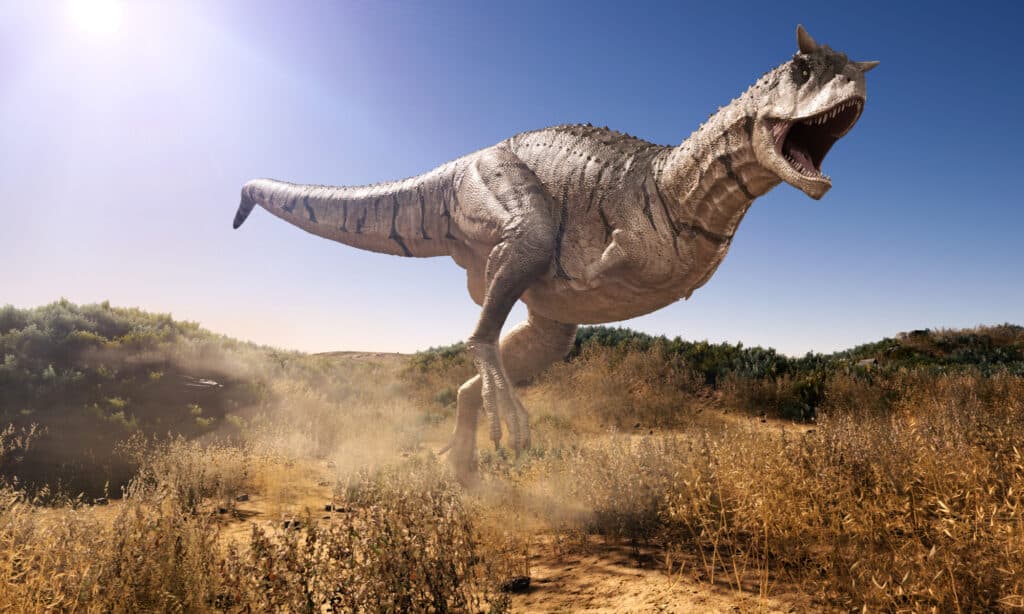
had thick horns above its eyes, a deep skull, and a very muscular neck.
©Herschel Hoffmeyer/Shutterstock.com
A much smaller theropod dinosaur beginning with C is Carnotaurus, which reached approximately 26 feet long. Carnotaurus lived during the Late Cretaceous period, around 69 to 71 million years ago, and fossils from it have been found in Argentina. Carnotaurus had a distinctive set of horns on its head which were around six inches long. However, it had a relatively short skull compared to other dinosaurs, as well as particularly short forearms. Carnotaurus was a carnivore and likely preyed on other dinosaurs. However, research has found that it had a flexible lower jaw, similar to that of a snake, which may have allowed it to maneuver its teeth into its prey in such a way as to prevent them from escaping its grasp.
5. Caudipteryx
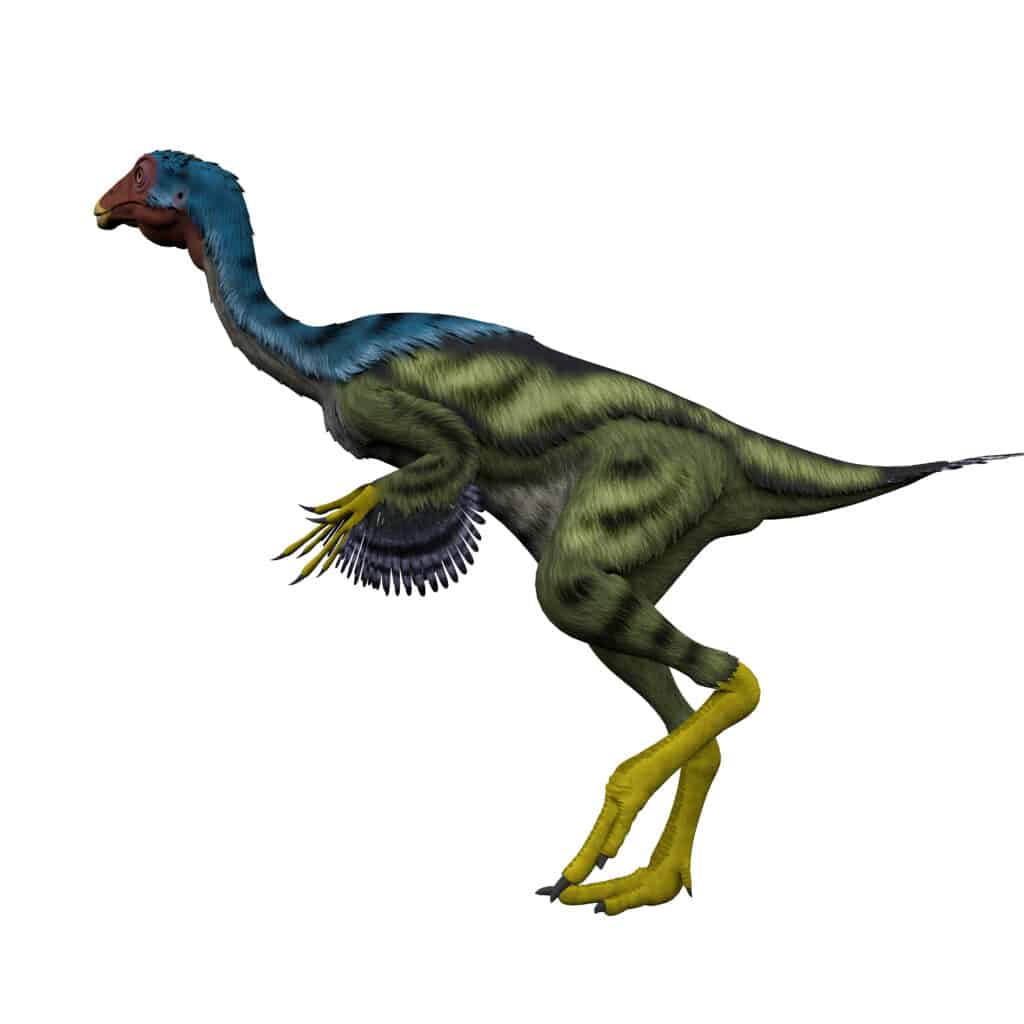
was a small bird-like dinosaur that lived in the Early Cretaceous period.
©iStock.com/CoreyFord
A small dinosaur with a name that means “tail feather” is Caudipteryx, which lived during the early Cretaceous period. Caudipteryx was a small therapod that had a distinctively bird-like appearance, largely owing to its feathered forearms and the fan of feathers on its tail. Caudipteryx was only around three feet long and had a short snout with only a few small teeth which were located in the upper jaw. It was likely an omnivore, eating insects and plants.
6. Centrosaurus
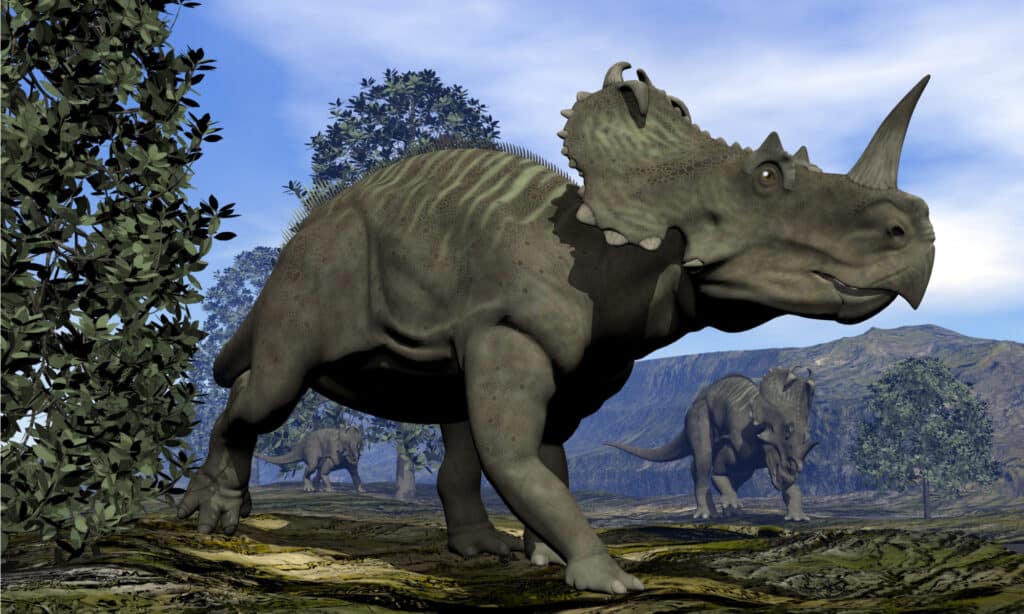
was a large dinosaur with a horn on its snout.
©Elenarts/Shutterstock.com
With a name that means “pointed lizard”, it’s easy to guess that Centrosaurus had horns. It was around 18 feet long and had a large horn on its snout and smaller horns above its eyes. However, it also had a frill on its neck, and it was the spikes around the frill that it was actually named for. Centrosaurus was a herbivore and would have eaten a variety of plants and vegetation. It lived during the Late Cretaceous period, approximately 76 to 74 million years ago.
7. Ceratosaurus

had small front legs and horns on its head.
©iStock.com/MR1805
Next is the Ceratosaurus, whose name means “horned lizard”. The name was given due to it having two horns on its head above its eyes, as well as a small horn on its snout. Ceratosaurus was around 18 feet long and was a carnivorous theropod and may have eaten a variety of smaller dinosaurs, fish, and reptiles. Ceratosaurus had particularly long teeth which were between six and seven inches long.
8. Chilesaurus
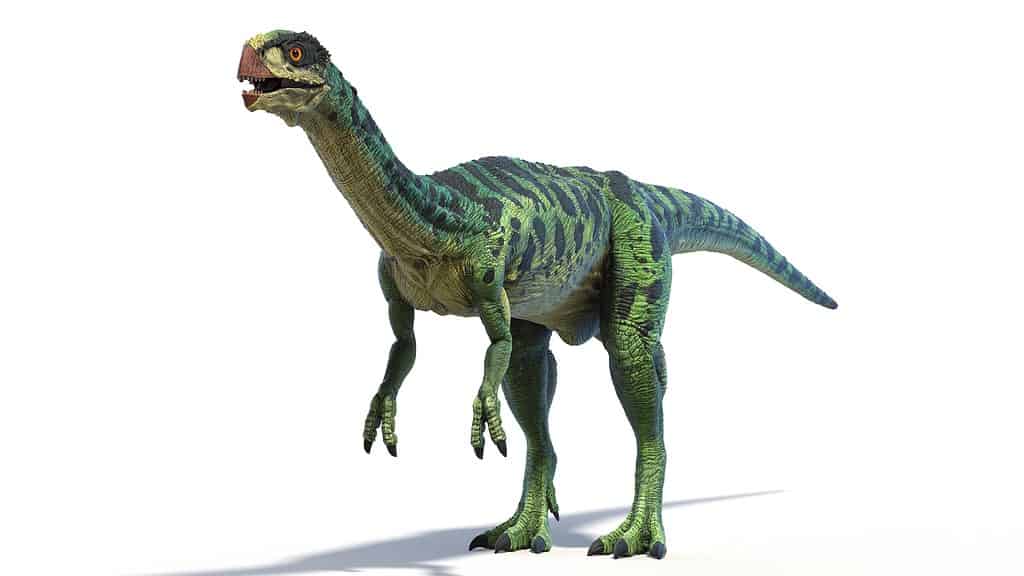
was an unusual dinosaur from the Late Jurassic period.
©SciePro/Shutterstock.com
As its name suggests, remains of Chilesaurus have been found in Chile, where it lived during the Late Jurassic period. Chilesaurus was a little over ten feet long but had an unusual set of characteristics which initially baffled scientists as it appeared to have traits of sauropods, theropods, and ornithischians. These features include long, forward-facing teeth, a pelvic bone that pointed backward, and a large claw on the forelimbs. The discovery of Chilesaurus is an important one for understanding the evolution of dinosaurs.
9. Chirostenotes
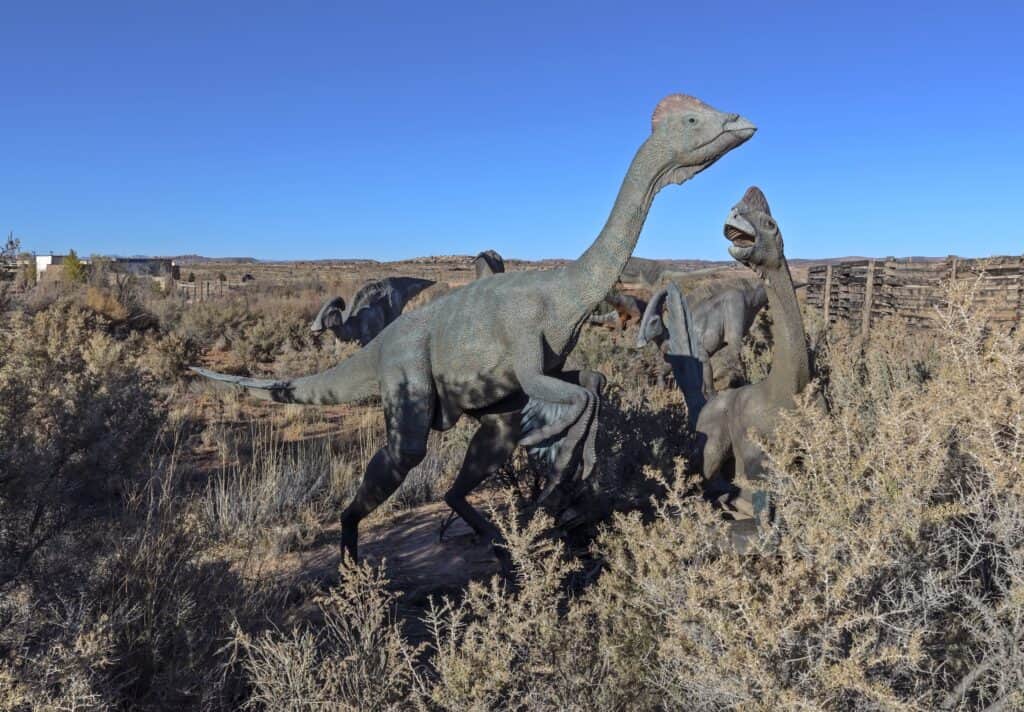
Chirostenotes had small hands and a crest on its head.
©Geofox/Shutterstock.com
Fossils from Chirostenotes were found in Canada, and the initial discovery was of a pair of small hands. This led to the name being coined which is derived from the Greek words for “narrow-handed”. As well as its particularly small forelimbs, Chirostenotes had fairly straight claws and powerful legs with an estimated length of eight feet. They lived during the Late Cretaceous era and were omnivorous, eating a mixture of insects, small animals, and possibly eggs.
10. Chungkingosaurus
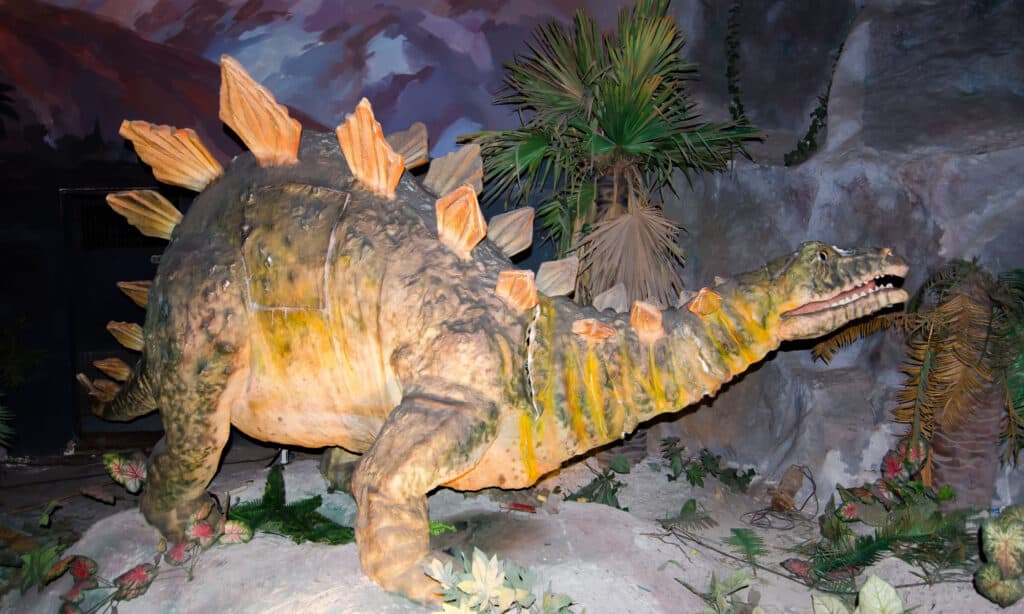
was a huge dinosaur with two rows of spikes on its back.
©ArliftAtoz2205/Shutterstock.com
Another herbivorous dinosaur beginning with C is Chungkingosaurus, which lived during the Late Jurassic period approximately 159 to 142 million years ago. Chungkingosaurus was a fairly small stegosaur, approximately 25 feet long. It is estimated to have had two rows of spikes on its back, as well as spikes on its tail. Fossils from Chungkingosaurus were found in China, with parts including part of the skull and part of the skeleton.
11. Coelophysis

was a theropod from the Late Triassic period.
©iStock.com/MR1805
A small theropod from the Late Triassic period is Coelophysis, which was up to ten feet long. Coelophysis lived across North America and Africa, with fossils found in South Africa and states such as Texas and New Mexico. Its name means “hollow form” due to it having hollow limb bones. Coelophysis was carnivorous, and it is thought that they preyed on small animals such as lizards.
12. Corythosaurus

had a distinctive crest on its head.
©SciePro/Shutterstock.com
The final dinosaur that we’re focusing on is the Corythosaurus, which was an ornithopod from the Late Cretaceous. Its name comes from the Greek words for “helmeted lizard” which is due to the large helmet-like structure on its head, somewhat similar to a cassowary crest. Corythosaurus reached around 30 feet long, and several almost entire skeletons have been discovered in Canada. Corythosaurus was a herbivore and is thought to have been a browser rather than a grazer, eating a variety of shrubs, leaves, and fruit.
Full List of All Dinosaurs Beginning With C
As well as the dinosaurs that we’ve highlighted above, there are still many more that begin with the letter C. Let’s take a quick look at them below.
- Caenagnathasia
- Caenagnathus
- Caieiria
- Caihong
- Calamosaurus
- Calamospondylus
- Callovosaurus
- Camarasaurus
- Camarillasaurus
- Camelotia
- Camposaurus
- Camptosaurus
- Campylodoniscus
- Canardia
- Carcharodontosaurus
- Cardiodon
- Carnotaurus
- Caseosaurus
- Cathartesaura
- Caudipteryx
- Cedarosaurus
- Cedarpelta
- Cedrorestes
- Centrosaurus
- Cerasinops
- Ceratonykus
- Ceratops
- Ceratosaurus
- Ceratosuchops
- Cetiosauriscus
- Cetiosaurus
- Changchunsaurus
- Changmiania
- Changyuraptor
- Chaoyangsaurus
- Charonosaurus
- Chasmosaurus
- Chebsaurus
- Chenanisaurus
- Chialingosaurus
- Chiayusaurus
- Chilantaisaurus
- Chilesaurus
- Chindesaurus
- Chingkankousaurus
- Chinshakiangosaurus
- Chirostenotes
- Choconsaurus
- Chondrosteosaurus
- Choyrodon
- Chromogisaurus
- Chuandongocoelurus
- Chuanjiesaurus
- Chuanqilong
- Chubutisaurus
- Chucarosaurus
- Chungkingosaurus
- Chuxiongosaurus
- Cionodon
- Citipati
- Citipes
- Claosaurus
- Clasmodosaurus
- Coahuilaceratops
- Coelophysis
- Coeluroides
- Coelurus
- Colepiocephale
- Coloradisaurus
- Comahuesaurus
- Compsognathus
- Compsosuchus
- Concavenator
- Conchoraptor
- Condorraptor
- Convolosaurus
- Coronosaurus
- Confuciusornis
- Corythoraptor
- Corythosaurus
- Craspedodon
- Craterosaurus
- Crichtonpelta
- Crichtonsaurus
- Cristatusaurus
- Crittendenceratops
- Cruxicheiros
- Cryolophosaurus
- Cryptosaurus
- Cryptovolans
- Cumnoria
The photo featured at the top of this post is © MR1805/iStock via Getty Images
Thank you for reading! Have some feedback for us? Contact the AZ Animals editorial team.






